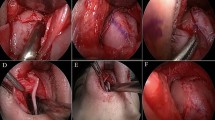Abstract
Background
Reconstruction of the middle third of the nose is crucial and middle vault insufficiency is possible following dorsal reduction in a primary rhinoplasty unless additional surgical measures are taken. The aim of this study was to define a novel suturing technique autospreading spring flap for middle vault reconstruction by suturing only the medial aspect of both upper lateral cartilages with septal quadrangular cartilage in a unique mattress suture and to mimic the natural anatomical configuration of the upper lateral and septal cartilages. This technique is intended to create functionality with aesthetic dorsal lines.
Methods
Fifteen volunteers with a significant osseocartilaginous dorsal hump underwent open rhinoplasty. The middle vault was reestablished using the ASSF technique that appositions only the medial part of the upper lateral cartilages and suturing it to the dorsal septal cartilage. Appearance of the nose before and after the operation was evaluated by the patients using a visual analog scale. Acoustic rhinometry (AR) was carried out preoperatively and postoperatively to determine nasal valve patency. Preoperative and postoperative symptoms were evaluated and compared using the nasal obstruction symptom evaluation (NOSE) scale.
Results
Patients (mean age = 32.2 ± 6.3 years) were followed for a mean of 12.6 months. The preoperative NOSE score was 65.0 ± 13 and the postoperative NOSE score was 7.7 ± 10. Cosmetic evaluation revealed the mean patient preoperative VAS score was 32.5 ± 20 and the postoperative VAS score was 88 ± 9. AR revealed a mean minimal cross-sectional area of 1.56 cm2 that increased to 2.16 cm2 postoperatively. Intranasal total volume increased from 16.3 to 24.8 cm3 postoperatively.
Conclusion
The newly defined autospreading spring flap suturing technique is a reliable method for reconstructing the nasal dorsum after humpectomy and for preventing middle vault and nasal valve collapse. The outcome was satisfactory, both aesthetically and functionally, but long-term follow-up is required.
Level of Evidence IV
This journal requires that authors assign a level of evidence to each article. For a full description of these Evidence-Based Medicine ratings, please refer to the Table of Contents or the online Instructions to Authors www.springer.com/00266.






Similar content being viewed by others
References
Sheen JH (1984) Spreader graft: a method of reconstructing the roof of the middle nasal vault following rhinoplasty. Plast Reconstr Surg 73:230–239
Constantian MB, Clardy RB (1996) The relative importance of septal and nasal valvular surgery in correcting airway obstruction in primary and secondary rhinoplasty. Plast Reconstr Surg 98:38–54 discussion 55–58
Gruber RP, Melkun ET, Woodward JF, Perkins SW (2011) Dorsal reduction and spreader flaps. Aesthet Surg J 31(4):456–464
Ozturan O (2000) Techniques for the improvement of the internal nasal valve in functional-cosmetic nasal surgery. Acta Otolaryngol 120(2):312–315
Byrd HS, Meade RA, Gonyon DL (2007) Using the autospreader flaps in primary rhinoplasty. Plast Reconstr Surg 119:1902–1987
Berkowitz RL (1995) Barrel vault technique for rhinoplasty. Presented at poster session of the 28th annual meeting of the American society for aesthetic plastic surgery, San Francisco
Oneal RM, Berkowitz RL (1998) Upper lateral cartilage spreader flaps in rhinoplasty. Aesthetic Surg J 18:370–371
Seyhan A (1997) Method for middle vault reconstruction in primary rhinoplasty: upper lateral cartilage bending. Plast Reconstr Surg 100:1941–1943
Lerma J (1995) Reconstruction of the middle vault: the “lapel” technique. Cir Plast Ibero Latinoam 21:207
Rohrich RJ (1999) Treatment of the nasal hump with preservation of the cartilaginous framework. Plast Reconstr Surg 103:1729–1733 discussion 1734–1735
Manavbaşı YI, Başaran I (2011) The role of upper lateral cartilage in dorsal reconstruction after hump excision: section 1. Spreader flap modification with asymmetric mattress suture and extension of the spreading effect by cartilage graft. Aesthetic Plast Surg 35(4):487–493
Gruber RP, Park E, Newman J, Berkowitz L, Oneal R (2007) The spreader flap in primary rhinoplasty. Plast Reconstr Surg 119(6):1903–1910
Ozturan O, Miman MC, Kizilay A (2002) Bending of the upper lateral cartilages for nasal valve collapse. Arch Facial Plast Surg 4(4):258–261
Seyhan A (1997) Method for middle vault reconstruction in primary rhinoplasty: upper lateral cartilage bending. Plast Reconstr Surg 100:1941–1943
Acartürk S, Gencel E (2003) The spreader-splay graft combination: a treatment approach for the osseocartilaginous vault deformities following rhinoplasty. Aesthetic Plast Surg 27:275–280
Fayman MS, Potgieter E (2004) Nasal middle vault support: a new technique. Aesthetic Plast Surg 28:375–380 discussion 381–282
Clement PA, Gordts F, Standardisation Committee on Objective Assessment of the Nasal Airway, IRS, and ERS (2005) Consensus report on acoustic rhinometry and rhinomanometry. Rhinology 43:169–179
Holmstrom M (2010) The use of objective measures in selecting patients for septal surgery. Rhinology 48(4):387–393
Skoog T (1966) A method of hump reduction in rhinoplasty. A technique for preservation of the nasal roof. Arch Otolaryngol 83(3):283–287
Ishida J, Ishida LC, Ishida LH, Vieira JC, Ferreira MC (1999) Treatment of the nasal hump with preservation of the cartilaginous framework. Plast Reconstr Surg 103(6):1729–1733 discussion 1734–1735
Constantinides MS, Adamson PA, Cole P (1996) The long-term effects of open cosmetic septorhinoplasty on nasal air flow. Arch Otolaryngol Head Neck Surg 122(1):41–45
Reiffel AJ, Cross KJ, Spinelli HM (2011) Nasal spreader grafts: a comparison of Medpor to autologous tissue reconstruction. Ann Plast Surg 66(1):24–28
Acknowledgments
We acknowledge audiometrists Kadriye Budak and Senem Ozturk for their diligent rhinologic assessments.
Conflict of interest
The authors have no conflicts of interest to disclose, no financial disclosures, and no funding sources.
Author information
Authors and Affiliations
Corresponding author
Rights and permissions
About this article
Cite this article
Eren, S.B., Tugrul, S., Ozucer, B. et al. Autospreading Spring Flap Technique for Reconstruction of the Middle Vault. Aesth Plast Surg 38, 322–328 (2014). https://doi.org/10.1007/s00266-014-0292-8
Received:
Accepted:
Published:
Issue Date:
DOI: https://doi.org/10.1007/s00266-014-0292-8




